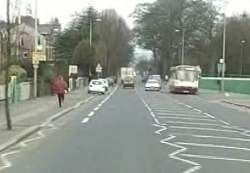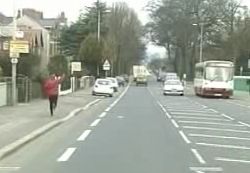Our mock hazard perception tests are here at the bottom of the page.
As a video clip showing a road traffic situation plays, you must identify a developing hazard: something that will cause the driver to change speed, direction, or stop.
When you see the hazard develop, click the mouse. The sooner you click, the more points you score. Five points are the maximum per hazard. Click too late, and you score zero.
There are fourteen clips. Thirteen show one hazard, and one shows two.
You cannot continuously click the mouse as the clip plays. If you do this, you will score zero. However, you will not lose points for clicking on other potential hazards that may also appear. The practice clips below will familiarize you with this.
As soon as you see a potential hazard forming, click the mouse, briefly pause, then click again. The hazard may not develop into an actual hazard, but because you clicked, you have covered yourself if it does.

Potential Hazard: The woman is running along the pavement. Does she want to catch the bus? Does she intend to hurry across the road? Maybe, but if you click now you won't score any points, as she is not an actual hazard only a potential one.

Developing Hazard: The woman is running along the pavement. Does she want to catch the bus? Does she intend to hurry across the road? Maybe. But if you click now, you won't score any points, as she is not an actual hazard, only a potential one.

Actual Hazard: The woman is on the road and has become an actual hazard. She has forced the driver to take action: to change speed, direction, or stop. The scoring window closes just before this action begins. If you click now, you will score nil points.
To pass the test, you must score at least 44 points out of a possible 75 points, and you must also pass the theory test, multiple-choice questions, which you will take before starting the hazard perception.
The test is the second part of the driving theory test. After you complete the theory multiple-choice questions, you will be permitted a break of up to 3 minutes. A short tutorial video explaining how the test works will then play. Once the video finishes, the test will begin. The test will last for around 20 minutes.
A road traffic hazard can be anything that causes a driver to change the speed, the direction, or stop the vehicle they are driving. Although real-life hazards may be static, such as a set of traffic lights, a junction, or a bend, these are not the hazards you will need to identify during the hazard perception test.
During the test, you will need to identify hazards that develop, and so have motion, such as a bus pulling away from a bus stop or a lollypop lady stepping into the road.
If you click the mouse too many times while taking the test, you will score zero for the clip.
How many are too many?
The DVSA does not reveal this. However, as they say, do the maths. Each hazard test is about one minute long. If you clicked once every two seconds (about thirty clicks in total) you would definitely click at least twice on the actual hazard while the scoring window was open, as the scoring window must be at least five seconds long. So, from this, can we conclude thirty clicks would be too many?
When driving a car, hazards can come from all directions and emerge from most road traffic situations. As learner drivers taking practical lessons with a driving instructor, you will encounter such hazards regularly. In doing so, you will learn a great deal about taking and passing the hazard test.
Think of the driving test as a single entity - not three separate tests. Practicing for the hazard perception test will help you pass the practical test and vice-versa.
Below is a list of road traffic hazards you will experience while driving. These hazards will appear in the hazard test as potential and actual hazards. When taking the test, if you see any of these potential hazards or situations, you should ask yourself how they, as potential hazards, may turn into actual hazards. Always be thinking, 'what if?'
General Driving
Residential Streets
Residential streets are full of potential hazards as they contain not just moving road traffic but pedestrians, cyclists, and parked vehicles restricting views and movement. Look out for:
Roads Near Schools
There is always a good chance that the hazard test will include a hazard by a school, as the powers that be, quite rightly, like to highlight the safety of children on our roads. Look out for:
Country Roads Hazards
If you are a learner driver who lives in a city or large town, it may be that you will never have a driving lesson on a rural road. This unfamiliarity with rural driving increases the likelihood that a rural hazard will appear in the hazard perception test, as the DVSA wants to prepare you for the day you do drive on a rural road. Look out for:
Motorway Hazards
To prepare and practice for the hazard perception test, try testing yourself. Take a journey by car and watch the road ahead. Numerous hazards will emerge. Some will develop, and others will not. Can you tell which? For the potential hazards that develop into actual hazards, ask yourself what action you would need to take to deal with them safely. Of course, the driving lessons you take in a car will give you a good insight into how potential hazards develop into actual hazards.
We have sixteen mock hazard tests for to try starting here with Hazard Perception Test 01